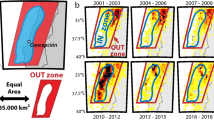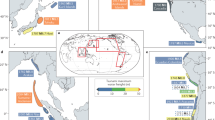Abstract
Many earthquakes are preceded by foreshocks1,2. However, the mechanisms that generate foreshocks and the reason why they occur before some earthquakes and not others are unknown3,4,5,6,7,8. Here we use seismic catalogues from the best instrumented areas of the North Pacific to analyse the foreshock sequences preceding all earthquakes there between 1999 and 2011, of magnitude larger than 6.5 and at depths shallower than 50 km. The data set comprises 31 earthquakes at plate boundaries, and 31 in plate interiors. We find that there is a remarkable contrast between the foreshock sequences of interplate compared with intraplate earthquakes. Most large earthquakes at plate interfaces in the North Pacific were preceded by accelerating seismic activity in the months to days leading up to the mainshock. In contrast, foreshocks are much less frequent in intraplate settings. We suggest that at plate boundaries, the interface between the two plates begins to slowly slip before the interface ruptures in a large earthquake. This relatively long precursory phase could help mitigate earthquake risk at plate boundaries.
This is a preview of subscription content, access via your institution
Access options
Subscribe to this journal
Receive 12 print issues and online access
$259.00 per year
only $21.58 per issue
Buy this article
- Purchase on Springer Link
- Instant access to full article PDF
Prices may be subject to local taxes which are calculated during checkout




Similar content being viewed by others
References
Jones, L. M. & Molnar, P. Frequency of foreshocks. Nature 262, 677–679 (1976).
Jones, L. M. & Molnar, P. Some characteristics of foreshocks and their possible relationship to earthquake prediction and premonitory slip on faults. J. Geophys. Res. 84, 3596–3608 (1979).
Abercrombie, R. E. & Mori, J. Occurrence patterns of foreshocks to large earthquakes in the western United States. Nature 381, 303–307 (1996).
Reasenberg, P. A. Foreshock occurrence before large earthquakes. J. Geophys. Res. 104, 4755–4768 (1999).
Jones, L. M. Foreshocks (1966–1980) in the San Andreas system, California. Bull. Seismol. Soc. Am. 74, 1361–1380 (1984).
Doser, D. I. Foreshocks and aftershocks of large (M>5.5) earthquakes within the western Cordillera of the United States. Bull. Seismol. Soc. Am. 80, 110–128 (1990).
Maeda, K. Time distribution of immediate foreshocks obtained by a stacking method. Pure Appl. Geophys. 155, 381–394 (1999).
McGuire, J. J., Boettcher, M. S. & Jordan, T. H. Foreshock sequences and short-term earthquake predictability on East Pacific rise transform faults. Nature 434, 457–461 (2005).
Dodge, D. A., Beroza, G. C. & Ellsworth, W. L. Foreshock sequence of the 1992 Landers, California, earthquake and its implications for earthquake nucleation. J. Geophys. Res. 100, 9865–9880 (1995).
Dodge, D. A., Beroza, G. C. & Ellsworth, W. L. Detailed observations of California foreshock sequences: Implications for the earthquake initiation process. J. Geophys. Res. 101, 22371–22392 (1996).
Zanzerkia, E. E., Beroza, G. C. & Vidale, J. E. Waveform analysis of the 1999 Hector Mine foreshock sequence. Geophys. Res. Lett. 30, 1429 (2003).
Hauksson, E. et al. The 2010 Mw 7.2 El Mayor-Cucapah earthquake sequence, Baja California, Mexico and southernmost California, USA: Active seismotectonics along the Mexican Pacific margin. Pure Appl. Geophys. 168, 1255–1277 (2011).
Kato, A., Obara, K., Igarashi, T., Tsuruoka, H., Nakagawa, S. & Hirata, N. Propagation of slow slip leading up to the 2011 Mw 9.0 Tohoku-Oki earthquake. Science 335, 705–708 (2012).
Bouchon, M., Karabulut, H., Aktar, M., Ozalaybey, S., Schmittbuhl, J. & Bouin, M.P. Extended nucleation of the 1999 Mw 7.6 Izmit earthquake. Science 331, 877–880 (2011).
Peng, Z. & Gomberg, J. An integrated perspective of the continuum between earthquakes and slow-slip phenomena. Nature Geosci. 3, 599–607 (2010).
Beroza, G. C. & Ide, S. Slow earthquakes and nonvolcanic tremor. Annu. Rev. Earth Planet. Sci. 39, 271–296 (2011).
Vidale, J. E. & Houston, H. Slow slip: A new kind of earthquake. Phys. Today 65, 38–43 (2012).
Pacheco, J., Sykes, L. R. & Scholz, C. H. Nature of seismic coupling along simple plate boundaries of subduction type. J. Geophys. Res. 98, 14133–14159 (1993).
Ohnaka, M. Earthquake source nucleation: A physical model for short term precursors. Tectonophysics 211, 149–178 (1992).
Hardebeck, J. L., Felzer, K. & Michael, A. J. Improved tests reveal that the accelerating moment release hypothesis is statistically insignificant. J. Geophys. Res. 113, B08310 (2008).
Helmstetter, A., Sornette, D. & Grasso, J. R. Mainshocks are aftershocks of conditional foreshocks: How do foreshock statistical properties emerge from aftershock laws. J. Geophys. Res. 108, 2046 (2003).
Ogata, Y. Statistical models for earthquake occurrence and residual analysis for point processes. J. Am. Stat. Assoc. 83, 9–27 (1988).
Madariaga, R., Métois, M., Vigny, C. & Campos, J. Central Chile finally breaks. Science 328, 181–182 (2010).
Suyehiro, S. Difference between aftershocks and foreshocks in the relationship of magnitude to frequency of occurrence for the great Chilean earthquake of 1960. Bull. Seismol. Soc. Am. 56, 185–200 (1966).
Acknowledgements
We thank J. R. Grasso, M. Campillo, F. Renard, P. Y. Bard, M. P. Bouin, O. Coutant, P. Bernard, L. Géli, P. Henry, R. Archuleta, O. Lengliné and G. Poupinet for discussions.
Author information
Authors and Affiliations
Contributions
M.B. and V.D. analysed the data and investigated the time and space evolutions. D.M. developed and performed the statistical analysis, H.K. and J.S. investigated the characteristics of the precursory phase. All authors contributed to the conclusions presented in the manuscript.
Corresponding authors
Ethics declarations
Competing interests
The authors declare no competing financial interests.
Supplementary information
Supplementary Information
Supplementary Information (PDF 918 kb)
Rights and permissions
About this article
Cite this article
Bouchon, M., Durand, V., Marsan, D. et al. The long precursory phase of most large interplate earthquakes. Nature Geosci 6, 299–302 (2013). https://doi.org/10.1038/ngeo1770
Received:
Accepted:
Published:
Issue Date:
DOI: https://doi.org/10.1038/ngeo1770
This article is cited by
-
Stress-driven recurrence and precursory moment-rate surge in caldera collapse earthquakes
Nature Geoscience (2024)
-
Deep learning forecasting of large induced earthquakes via precursory signals
Scientific Reports (2024)
-
The preparatory process of the 2023 Mw 7.8 Türkiye earthquake
Scientific Reports (2023)
-
Months-long seismicity transients preceding the 2023 MW 7.8 Kahramanmaraş earthquake, Türkiye
Nature Communications (2023)
-
Evaluation of Thermal anomaly Preceding Northern Red Sea Earthquake, the 16th June 2020
Arabian Journal for Science and Engineering (2022)



